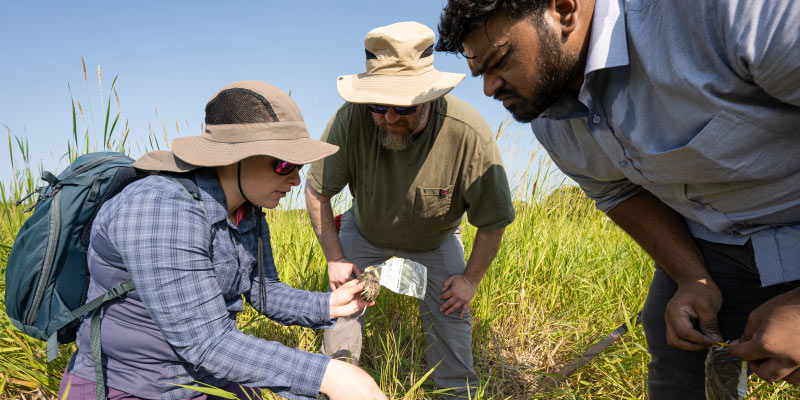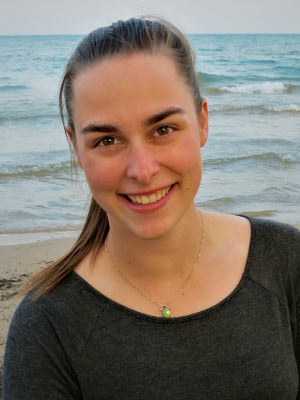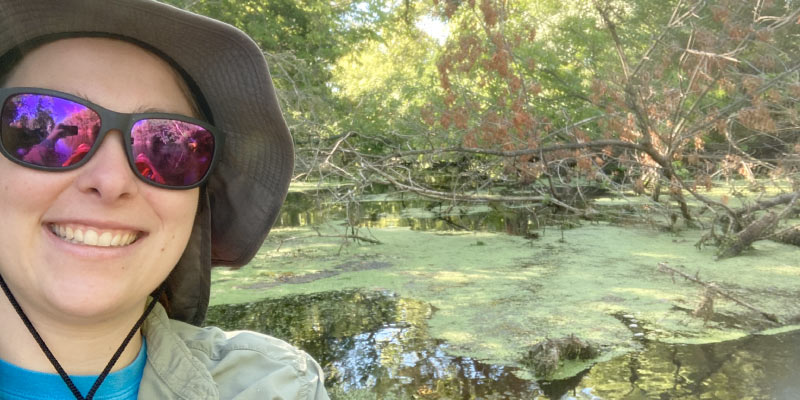
For Heidi Putnam, water resource conservation is less about understanding the hard sciences than it is about understanding the communities relying on those water resources. “In the past, I had always thought that in order to do water resource management I had to be a ‘hardcore science’ person,” Putman says, “and that might be part of your job, but I think the biggest skillset you need in this field is being able to connect with people.”
During her undergraduate education at the University of Wisconsin–Stevens Point, took an introductory geographic information system (GIS) course and stumbled upon the college’s natural resource planning major. “I remember thinking it was perfect. It had a blend of basic management tactics for natural resources — understanding the natural environment and the social side of things — as well as GIS and analysis on the computer end,” she says.

Putnam took initiative to learn as much as she could and solve as many problems as possible around the UWSP campus. She says, “I would take classes in the winter and summer so I could take low-credit semesters and pursue opportunities. I ended up working for the Department of Natural Resources, the sustainability office on campus, and the Schmeeckle Reserve, which is UWSP’s nature reserve.”
As an extra challenge, Putnam decided to tackle the issue of increasing the bike infrastructure in and around campus. She says, “When I was with the sustainability office, a lot of my work included looking at greenhouse gas emissions and pedestrian bike planning. I saw a need for change and wanted to do something about it!” Putnam volunteered to write an application for the campus to be recognized as a Bike Friendly University, and earned UWSP the bronze-level certification.
In 2020, Putnam graduated from UWSP with a degree in natural resource planning and landed a position at a small engineering firm based in Sheboygan, Wis. “The company specialized in a lot of agricultural sites and shoreline properties. Shoreline protection and wetland protection are right up my alley, so I worked there for about two years,” Putnam says.
While working there, she learned a lot about the engineering industry, but wanted to work more with people and planning — however, she needed to further her education in order to do so. “At my job, I learned a lot of tangible skills that you can’t learn in the classroom, but I had a knowledge gap that was preventing me from moving up,” she says. Consequently, Putnam decided to pursue a master’s degree in the urban and regional planning program (URPL) with UW–Madison’s Department of Planning and Landscape Architecture (DPLA).
The summer before starting her master’s degree at UW–Madison, Putnam found a short-term position in watershed planning with the Vilas County Land and Water Conservation Department. Putnam knew she wanted to work in water resources conservation, but this job was the turning point in her career. The fieldwork and human relations aspects of her work with the Land and Water Conservation Department truly solidified her desire to have a career in watershed planning. “It was a dream-job, career-goal situation,” Putnam says. “That job was one of the most influential experiences in my wanting to have a career emphasis in watershed planning.”

Putnam arrived on campus in the fall of 2022 to start her URPL coursework, and in the spring of 2023 decided to add on a second master’s degree in the Nelson Institute’s water resources management (WRM) program. Last spring, Putnam was named the inaugural recipient of the Jim Miller Scholarship for Excellence in Water Resource Management. She says, “A lot of the DPLA classes I’m taking are about interacting with people, analyzing data, and representing data visually, which is a really good foundation,” Putnam says. “But then the WRM program comes in with the hard sciences and practicum experience, which are also important.” While she has since taken a step back from her WRM coursework, Putnam continues to be involved in the WRM practicum project.
The Water Resource Management’s practicum project provides students with real-world experience in solving problems related to water resources. Putnam’s cohort is focusing their practicum project on the Koshkonong Creek, located east of Madison, and is working with the Friends of Koshkonong Creek (FOKC). “[The FOKC] were concerned with the amount of obstructions from fallen trees that were occurring in the creek, because the trees would dam up the creek and prevent waterflow,” Putnam says.
Putnam and her cohort tackle issues with flooding, sedimentation, and obstructions in the creek. “We wanted to explore options for controlling the water, reducing the sediment, and restoring some of the lands that were flooded,” Putnam says. “We started to look at what municipalities, individual landowners, and the county should do to form an alliance in addressing those concerns.”
Currently, her cohort is working on compiling a report analyzing one of the sub-watersheds within Koshkonong Creek that contains many of the issues identified by the FOKC. With their analysis, the team examines the activity impacting the watershed and what can be done to mitigate damage. They’ve also built an app for community members to send “maintenance requests” to the FOKC in order to keep the creek healthy, proposed kayak launches to increase access to the creek, and created a project hub site for people interested in the creek’s restoration. The project is scheduled to wrap up in the spring of 2024.
While working on her master’s degree, Putnam wanted to keep making progress towards her career goal of working in watershed planning. Last spring, she met with MSA Professional Services at a career fair and started a part-time position. While her current job duties are related to agriculture and stormwater projects, Putnam will transition into an environmental planning role this spring and plans to keep working for MSA after graduation.
For anyone working in conservation, Putnam emphasizes the importance of connecting with the communities being served — truly seeking to understand what needs aren’t being met, and what solutions are feasible. “People don’t realize that in order to be successful in this field, you need to understand the human component in addition to the hard sciences.” she says. “If you can’t have amicable discussions with people, you’re not going to get anywhere with resource management.”